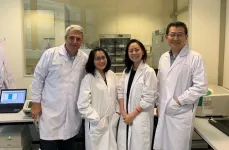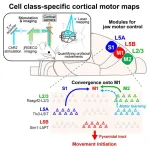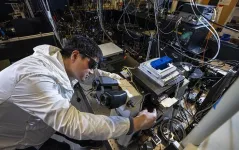(Press-News.org) About The Study: In this study, confidence in organizations to use health data responsibly was largely unchanged from 2020 to 2022, but polarization increased between politically liberal and conservative respondents. Compared with 2020, in 2022 liberal respondents reported increased confidence in the federal government to use digital health data responsibly, while conservative respondents reported decreased confidence in the federal government and agencies. Changes in confidence may be related to the prominence of these agencies (CDC, NIH) during the COVID-19 pandemic, a 2020 national election with a change in the governing political party, and political polarization.
Corresponding Author: To contact the corresponding author, Ravi Gupta, MD, MSHP, email ravigupta@jhmi.edu.
To access the embargoed study: Visit our For The Media website at this link https://media.jamanetwork.com/
(doi:10.1001/jamanetworkopen.2024.61907)
Editor’s Note: Please see the article for additional information, including other authors, author contributions and affiliations, conflict of interest and financial disclosures, and funding and support.
# # #
Embed this link to provide your readers free access to the full-text article This link will be live at the embargo time https://jamanetwork.com/journals/jamanetworkopen/fullarticle/10.1001/jamanetworkopen.2024.61907?guestAccessKey=c0957767-f5eb-4d6d-88a4-15c747418b57&utm_source=for_the_media&utm_medium=referral&utm_campaign=ftm_links&utm_content=tfl&utm_term=022625
About JAMA Network Open: JAMA Network Open is an online-only open access general medical journal from the JAMA Network. On weekdays, the journal publishes peer-reviewed clinical research and commentary in more than 40 medical and health subject areas. Every article is free online from the day of publication.
END
Consumer confidence in the responsible use of digital health data after the COVID-19 pandemic
JAMA Network Open
2025-02-26
ELSE PRESS RELEASES FROM THIS DATE:
Influencers promoting ‘overwhelmingly’ misleading information about medical tests on social media
2025-02-26
Influencers are promoting “overwhelmingly” misleading information about medical tests on Instagram and TikTok, according to a global University of Sydney-led study published today in JAMA Network Open.
Researchers analysed almost 1000 posts about five controversial medical screening tests that had been promoted by social media influencers to almost 200 million followers. They found most posts had no reference to scientific evidence, were promotional, had explicit financial interests and failed to mention potential harms.
The ...
Two papers by Walhout lab in Nature highlight novel metabolic principles
2025-02-26
Two papers published today in the journal Nature describe a significant advance in understanding the complex functions of the metabolic network. The research is from the lab of Marian Walhout, PhD, the Maroun Semaan Chair in Biomedical Research and chair and professor of systems biology, which has been engaged with fundamental questions of metabolism for more than a decade.
According to Dr. Walhout, organisms constantly monitor their nutrient intake and adjust their metabolism to generate biomass and energy; their ...
Multiplexing entanglement in a quantum network
2025-02-26
Laying the groundwork for quantum communication systems of the future, engineers at Caltech have demonstrated the successful operation of a quantum network of two nodes, each containing multiple quantum bits, or qubits—the fundamental information-storing building blocks of quantum computers.
To achieve this, the researchers developed a new protocol for distributing quantum information in a parallel manner, effectively creating multiple channels for sending data, or multiplexing. The work was accomplished by embedding ytterbium atoms ...
Bacteria consumed by immune cells become part of the cell
2025-02-26
Immune cells that eat bacteria in the body don’t stash them in specialized compartments as once thought, but turn them into critical nutrients that build proteins, create energy and keep the cells alive, according to a new study from scientists at the University of Colorado Anschutz Medical Campus.
“We are what we eat,” said the study’s co-senior author Angelo D’Alessandro, Ph.D., professor of biochemistry and molecular genetics at the University of Colorado School of Medicine at CU Anschutz. “What we eat changes the composition of us and when immune cells eat bacteria the same thing happens to them.”
The ...
CSIC researchers discover how the brain builds sophisticated maps to navigate and remember the world
2025-02-26
The brain creates internal 'maps' to help us navigate and learn from our surroundings, but how these maps form remains a challenge to understand. Now, a study led by Liset M. de la Prida at the Cajal Neurosciences Center (CNC-CSIC) in Madrid, in collaboration with Imperial College London, offers a fresh perspective on how spatial and experiential information is encoded in the hippocampus, a key brain region for navigation and memory.
The study published today in Neuron, reveals that two types of hippocampal ...
New spatial mechanism for the coexistence of tree species
2025-02-26
The data sets are very large: with more than 75 permanent forest dynamics plots in 29 countries worldwide, the Forest Global Earth Observatory network (ForestGEO) of the Smithsonian Tropical Research Institute (STRI) provides excellent forest inventories for investigating the dynamics of forest ecosystems and better understanding the processes that drive the structure and function of forests. On these 20-to-50-hectare plots, every single tree with a diameter not much larger than a pencil has been identified, measured and mapped every five years, often totalling more than 200 000 trees. The two UFZ researchers, Dr. Thorsten Wiegand ...
City of Hope research features myeloma study, cancer surgery and more
2025-02-26
This roundup highlights a common drug that can help treat multiple myeloma, a paper analyzing the benefit of a colorectal surgery follow-up test, recommendations for implementing remote patient monitoring for care received before, during and after surgery, details on how often women with an elevated breast cancer risk are receiving enhanced screenings, and clinical trial results for a new chimeric antigen receptor (CAR) T cell therapy targeting B cell acute lymphoblastic leukemia.
To learn more about research at City of Hope, one of the largest and most advanced cancer research and treatment organizations in the U.S. with its ...
A*STAR spin-off NalaGenetics implements nationwide drug reaction screening for leprosy patients in Indonesia
2025-02-26
SINGAPORE – NalaGenetics, a spin-off from A*STAR Genome Institute of Singapore (A*STAR GIS), will be transforming leprosy treatments in Indonesia with a nationwide genetic screening programme with their PGx1301 diagnostic kit. Set to launch in the fourth quarter of 2025, this initiative builds on a successful five-year pilot test in East Indonesia, which demonstrated the effectiveness of precision medicine in preventing life-threatening adverse drug reactions (ADRs).
As part of this programme, up ...
Unraveling the brain’s hidden motor modules
2025-02-26
For nearly a century, scientists have known that different parts of the human brain’s cortex control different body movements. This fundamental discovery dates to the 1930s, when neurosurgeons used electrical stimulation to map how different cortical regions correspond to different body parts.
But can these regions be further broken down into even smaller functional components? Researchers have long suspected that cortical units for specific body movements are more complex than simple patches in the cortex. Studies have identified various types of neurons stacked in multiple layers across the neocortex, but without a clear picture of how these ...
New photon-avalanching nanoparticles could enable next-generation optical computers
2025-02-26
A research team co-led by Lawrence Berkeley National Laboratory (Berkeley Lab), Columbia University, and Universidad Autónoma de Madrid has developed a new optical computing material from photon avalanching nanoparticles.
The breakthrough – which the team published recently in the journal Nature Photonics – paves the way for fabricating optical memory and transistors on a nanometer size scale comparable to current microelectronics. This approach offers a path toward realizing smaller, faster components for next-generation ...
LAST 30 PRESS RELEASES:
UVA’s Jundong Li wins ICDM’S 2025 Tao Li Award for data mining, machine learning
UVA’s low-power, high-performance computer power player Mircea Stan earns National Academy of Inventors fellowship
Not playing by the rules: USU researcher explores filamentous algae dynamics in rivers
Do our body clocks influence our risk of dementia?
Anthropologists offer new evidence of bipedalism in long-debated fossil discovery
Safer receipt paper from wood
Dosage-sensitive genes suggest no whole-genome duplications in ancestral angiosperm
First ancient human herpesvirus genomes document their deep history with humans
Why Some Bacteria Survive Antibiotics and How to Stop Them - New study reveals that bacteria can survive antibiotic treatment through two fundamentally different “shutdown modes”
UCLA study links scar healing to dangerous placenta condition
CHANGE-seq-BE finds off-target changes in the genome from base editors
The Journal of Nuclear Medicine Ahead-of-Print Tip Sheet: January 2, 2026
Delayed or absent first dose of measles, mumps, and rubella vaccination
Trends in US preterm birth rates by household income and race and ethnicity
Study identifies potential biomarker linked to progression and brain inflammation in multiple sclerosis
Many mothers in Norway do not show up for postnatal check-ups
Researchers want to find out why quick clay is so unstable
Superradiant spins show teamwork at the quantum scale
Cleveland Clinic Research links tumor bacteria to immunotherapy resistance in head and neck cancer
First Editorial of 2026: Resisting AI slop
Joint ground- and space-based observations reveal Saturn-mass rogue planet
Inheritable genetic variant offers protection against blood cancer risk and progression
Pigs settled Pacific islands alongside early human voyagers
A Coral reef’s daily pulse reshapes microbes in surrounding waters
EAST Tokamak experiments exceed plasma density limit, offering new approach to fusion ignition
Groundbreaking discovery reveals Africa’s oldest cremation pyre and complex ritual practices
First breathing ‘lung-on-chip’ developed using genetically identical cells
How people moved pigs across the Pacific
Interaction of climate change and human activity and its impact on plant diversity in Qinghai-Tibet plateau
From addressing uncertainty to national strategy: an interpretation of Professor Lim Siong Guan’s views
[Press-News.org] Consumer confidence in the responsible use of digital health data after the COVID-19 pandemicJAMA Network Open





